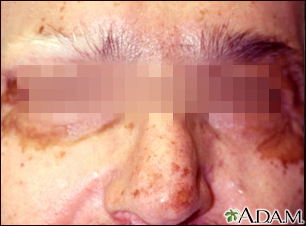Abnormally dark or light skin
Hyperpigmentation; Hypopigmentation; Skin - abnormally light or dark
Abnormally dark or light skin is skin that has turned darker or lighter than normal.
Images








I Would Like to Learn About:
Considerations
Normal skin contains cells called melanocytes. These cells produce melanin, the substance that gives skin its color.
Skin with too much melanin is called hyperpigmented skin.
Skin with too little melanin is called hypopigmented. Skin with no melanin at all is called depigmented.
Pale skin areas are due to too little melanin or underactive melanocytes. Darker areas of skin (or an area that tans more easily) occurs when you have more melanin or overactive melanocytes.
Bronzing of the skin may sometimes be mistaken for a suntan. This skin discoloration often develops slowly, starting at the elbows, knuckles, and knees and spreading from there. Bronzing may also be seen on the soles of the feet and the palms of the hands. The bronze color can range from light to dark (in fair-skinned people) with the degree of darkness due to the underlying cause.
Causes
Causes of hyperpigmentation include:
- Skin inflammation (post-inflammatory hyperpigmentation)
- Use of certain drugs (such as minocycline, certain cancer chemotherapies, and birth control pills)
- Hormone system diseases such as Addison disease
- Hemochromatosis (iron overload)
- Sun exposure
- Pregnancy (melasma, or mask of pregnancy)
- Certain birthmarks
- Skin condition called acanthosis nigricans
Causes of hypopigmentation include:
- Skin inflammation (post-inflammatory hypopigmentation)
- Certain fungal infections (such as tinea versicolor)
- Pityriasis alba
- Vitiligo
- Certain medicines
- Skin condition called idiopathic guttate hypomelanosis in sun exposed areas such as the arms
- Certain birthmarks
Home Care
Over-the-counter and prescription creams are available for lightening the skin. Hydroquinone combined with tretinoin is an effective combination. If you use these creams, follow instructions carefully, and don't use one for more than 3 weeks at a time. Darker skin requires greater care when using these preparations. Cosmetics may also help mask a discoloration.
Avoid too much sun exposure. Always use sunscreen with an SPF of 30 or higher.
Abnormally dark skin may continue even after treatment.
When to Contact a Medical Professional
Call your health care provider for an appointment if you have:
- Skin discoloration that causes significant concern
- Persistent, unexplained darkening or lightening of the skin
- Any skin sore or lesion that changes shape, size, or color may be a sign of skin cancer
What to Expect at Your Office Visit
Your provider will perform a physical exam and ask about your symptoms, including:
- When did the discoloration develop?
- Did it develop suddenly?
- Is it getting worse? How fast?
- Has it spread to other parts of the body?
- What medicines do you take?
- Has anyone else in your family had a similar problem?
- How often are you in the sun? Do you use a sun lamp or go to tanning salons?
- What is your diet like?
- What other symptoms do you have? For example, are there any rashes or skin lesions?
Tests that may be done include:
- Adrenocorticotrophin hormone stimulation test
- Skin biopsy
- Thyroid function studies
- Wood lamp test
- KOH test
Your provider may recommend creams, ointments, surgery, or phototherapy, depending on the type of skin condition you have. Bleaching creams can help lighten dark areas of skin.
Some skin color changes may return to normal without treatment.
Related Information
Patchy skin colorMelanin
Paleness
Benign
References
Chang MW. Disorders of hyperpigmentation. In: Bolognia JL, Schaffer JV, Cerroni L, eds. Dermatology. 4th ed. Philadelphia, PA: Elsevier; 2018:chap 67.
Passeron T, Ortonne JP. Vitiligo and other disorders of hypopigmentation. In: Bolognia JL, Schaffer JV, Cerroni L, eds. Dermatology. 4th ed. Philadelphia, PA: Elsevier; 2018:chap 66.
BACK TO TOPReview Date: 6/7/2023
Reviewed By: Elika Hoss, MD, Assistant Professor of Dermatology, Mayo Clinic, Scottsdale, AZ. Also reviewed by David C. Dugdale, MD, Medical Director, Brenda Conaway, Editorial Director, and the A.D.A.M. Editorial team.

Health Content Provider
06/01/2025
|
A.D.A.M., Inc. is accredited by URAC, for Health Content Provider (www.urac.org). URAC's accreditation program is an independent audit to verify that A.D.A.M. follows rigorous standards of quality and accountability. A.D.A.M. is among the first to achieve this important distinction for online health information and services. Learn more about A.D.A.M.'s editorial policy, editorial process and privacy policy. A.D.A.M. is also a founding member of Hi-Ethics. This site complied with the HONcode standard for trustworthy health information from 1995 to 2022, after which HON (Health On the Net, a not-for-profit organization that promoted transparent and reliable health information online) was discontinued. |
The information provided herein should not be used during any medical emergency or for the diagnosis or treatment of any medical condition. A licensed medical professional should be consulted for diagnosis and treatment of any and all medical conditions. Links to other sites are provided for information only -- they do not constitute endorsements of those other sites. © 1997- 2025 A.D.A.M., a business unit of Ebix, Inc. Any duplication or distribution of the information contained herein is strictly prohibited.
